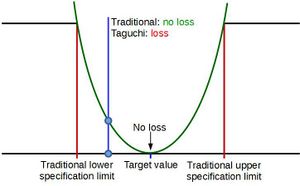Genichi Taguchi: Difference between revisions
(Infobox update) |
(The LinkTitles extension automatically added links to existing pages (<a target="_blank" rel="noreferrer noopener" class="external free" href="https://github.com/bovender/LinkTitles">https://github.com/bovender/LinkTitles</a>).) |
||
| Line 15: | Line 15: | ||
[[Image:G_Taguchi.gif|right|frame|Genichi Taguchi]] | [[Image:G_Taguchi.gif|right|frame|Genichi Taguchi]] | ||
'''Genichi Taguchi''' (Jan 1, 1924 - June 2, 2012) was an Japanese engineer and statistican, who applied statistical methods to manufacturing of goods. | '''Genichi Taguchi''' (Jan 1, 1924 - June 2, 2012) was an Japanese engineer and statistican, who applied [[statistical methods]] to manufacturing of goods. | ||
Takamachi, city where Taguchi was born, was famous for the kimono [[industry]]. His family expected him to study textile engineering, but due to World War II he had to stop studying. After war he changed interests and started to study statistics. | Takamachi, city where Taguchi was born, was famous for the kimono [[industry]]. His family expected him to study textile engineering, but due to World War II he had to stop studying. After war he changed interests and started to study statistics. | ||
Revision as of 06:00, 20 January 2023
| Genichi Taguchi |
|---|
| See also |
Genichi Taguchi (Jan 1, 1924 - June 2, 2012) was an Japanese engineer and statistican, who applied statistical methods to manufacturing of goods.
Takamachi, city where Taguchi was born, was famous for the kimono industry. His family expected him to study textile engineering, but due to World War II he had to stop studying. After war he changed interests and started to study statistics.
He worked for Japanese Ministry of Public Health and Welfare, where he started to work on design of experiments idea. As Kaoru Ishikawa, he was under the influence of William Edwards Deming. He gained experience while working for Electrical Communications Laboratory for 12 years. After this, he began to consult in Japanese industry. At that time, he also worked as a visiting professor in Japanese and American institutes. In 50-ties he worked in Indian Statistics Institute with Walter A. Shewhart.
Taguchi's ideas are widely used today in many industries. Due to level of sophistication, they are often less known than achievements of Deming, Juran or Ishikawa.
Biography
- 1942 - Astronomical Department of the Navigation Institute of the Imperial Japanese Navy
- 1948 - work in Ministry of Public Health and Welfare and Institute of Statistical Mathematics
- 1950 - Nippon Telegraph and Telephone Corporation
- 1954-1955 - visiting professor at the Indian Statistical Institute
- 1962 - doctorate at Kyushu University
- 1964 - professor of engineering at Aoyama Gakuin University, Tokyo
- 1980 - renewal of contacts with Bell Labs which lead to popularization ot Taguchi's mathods
- 1982 - advisor of Japanese Standards Institute
Taguchi methods
Genichi Taguchi was author of several methods, including:
- Design of experiments,
- Off-line quality control,
- Quality loss function.
Design of experiments
Design of experiments is the method of designing tasks in a way that allows find explanations of variation. Origins of systematic trials can be found in 18th century. Considerable improvement was possible thanks to statistical methods developed by Ronald Fisher and used by Genichi Taguchi. Experiments allow reduce number of errors and defects not only on production line, but also other areas, e.g. in medicine.
Quality loss function
The largest share in global losses of quality are these manifesting themselves in the longer term, related to consumer dissatisfaction, loss of market, increased stocks, performance drop, etc. In order to estimate them the quality loss function is used. The way the loss function is defined depends on the type of quality characteristics.
Off-line quality control
In order to achieve robust production process, it is necessary to collect data about quality and analyse it. The data can contain two types of information: signal and noise. The former is related to process operations and can be controlled, while the latter is random. The aim of off-line quality control is to reduce impact of noise on the product to the minimum.
References
- Taguchi design - part of lecture on statistics (NIST)
- Kok-Zuea T., Kok-Kiong T., Tong-Heng L. (2015) Taguchi Method Using Intelligent Techniques, Intelligent System Reference Library, 97, 389-419
- Lai-Kow Chan, Ming-Lu Wu (2002) Quality function deployment: A literature review, European Journal of Operational Research, 143(3)
Author: Slawomir Wawak

